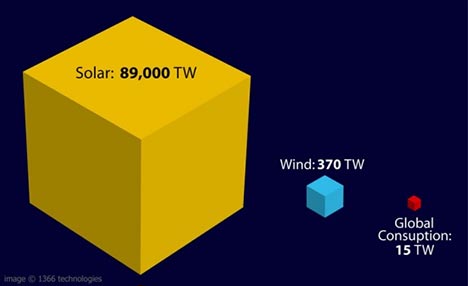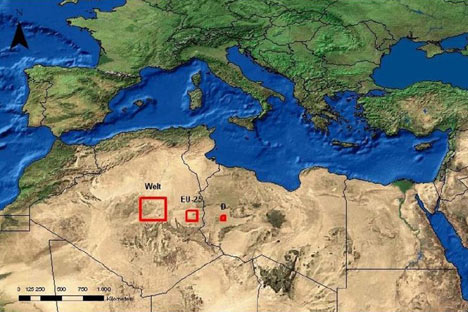There's a good chance that you've heard somewhere that "there's more than enough energy coming from the sun to power all of humanity". Today, what I'd like to do is look a bit more closely at that statement to see if it is true, and then put it in perspective.
Of course, if we wanted to power the whole world with solar power, there would be many problems to solve. What to do at night (this might be a solution)? Long distance transmission lines? centralized, or decentralized? Solar thermal, or photovoltaic? Where to put the solar power plants (on commercial rooftops, maybe)? etc.
But lets leave all of those questions for another time and focus on just two aspects for now: How much solar energy is hitting the Earth, and how much land would it take to power the whole world with solar power?
As you can see in the image below, there's a lot of solar energy potentially available to us. Even wind power (which is also caused by the sun) is a lot compared to total world energy consumption:

Now, lets look at how much land it would take to harness enough of that solar energy to power the whole world. That might seem like a straightforward question, but the answer will depend on the assumptions you make. Below are images from two different studies.
The first one is from Germany and assumes solar thermal power plants in the African desert.

The three red squares, in order from left to right, represent what would be required for the whole world, for the 25 European countries, and for Germany. Of course, if we were to really do this, not all solar power plants would be centralized like that, but as I said in the intro, we're just looking at how much land it would take, not at the details.
The second study spreads the solar power plants in 6 "hot spots" around the world: North-America, South-America, North Africa, the Middle-East, Central Asia and Australia. It assumes a conversion efficiency of 8% (which is conservative, we can do much better).

The colors in the map show the local solar irradiance averaged over three years from 1991 to 1993 (24 hours a day) taking into account the cloud coverage available from weather satellites
I think that's enough to give you a sense of scale. It's a lot of land, but if it was spread among a few deserts (for solar thermal power) and already existing rooftops (for photovoltaic), it would be manageable.
In future articles we'll look at some of the most promising new clean energy technologies.